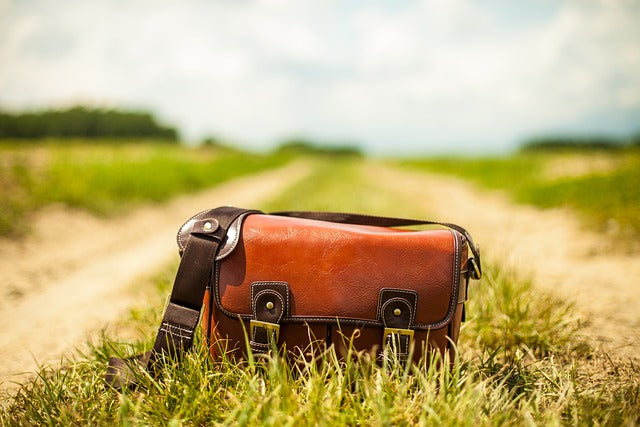Handbag customization has grown in popularity over the years, with fashion enthusiasts and DIY crafters alike seeking ways to make their accessories stand out. A handbag is more than just a functional item; it can be a canvas for creativity and personal expression. Whether you're looking to revive an old favorite or create a completely unique design, using leather paint on handbags is a fun and practical way to achieve a one-of-a-kind look.

This guide will walk you through how to paint leather handbags, from preparation to the finishing touches. With the right techniques and materials, you can turn any handbag into a stylish, one-of-a-kind masterpiece that showcases your personal style.
Materials Needed
Before diving into your handbag customization project, gathering the right tools and materials is essential to ensure a smooth and durable finish.

Essential Tools and Materials:
- Leather Preparer and Deglazer: These products are crucial for cleaning the surface and removing existing finishes or oils from the leather, ensuring proper paint adhesion.
- Leather Paints: Opt for high-quality leather paints that are flexible and designed specifically for leather surfaces.
- Brushes: A variety of brushes will be needed for different areas of your design. Flat brushes are ideal for broad coverage, while fine-tipped brushes are perfect for detailing.
- Masking Tape: Use masking tape to protect areas of the handbag that you don't want to paint and to create clean, sharp lines.
- Stencils: These are useful if you want to incorporate patterns, shapes, or lettering into your design.
- Leather Finisher: A good leather finisher will seal and protect your painted design, ensuring it stays vibrant and durable over time.
Importance of Choosing the Right Products
Selecting high-quality products is critical when customizing a handbag. Leather is a flexible material that moves and stretches, so using paints and finishers specifically designed for leather is necessary to prevent cracking or peeling. For example, Angelus Leather Paint is a top choice for its ability to bond with leather and its wide range of vibrant colors that won’t fade easily.

Preparing the Handbag
Preparation is key to ensuring that the paint adheres properly to the leather surface and lasts for years. Here’s how to get your handbag ready for painting:
Step-by-Step Guide to Preparation
- Clean the Surface: Start by wiping down the entire handbag with a damp cloth to remove any dust or dirt. This will ensure that nothing interferes with the paint adhering to the surface.
- Apply Leather Preparer and Deglazer: Once the handbag is clean, use a leather preparer and deglazer to remove any oils, waxes, or previous finishes from the leather. This step is essential because it ensures the paint will adhere properly without any barriers. Apply the deglazer with a soft cloth, rubbing it gently across the leather.
- Let It Dry: Allow the handbag to dry completely before moving on to painting. This will prevent moisture from getting trapped under the paint, which could cause cracking or peeling later on.
Proper preparation sets the foundation for a flawless finish, so don’t rush this step.
Design Planning and Masking
Before applying paint, planning your design is crucial. Whether you’re opting for a bold statement or a subtle accent, having a clear idea of your design will help you achieve the best results.
Planning Your Design
- Sketch Your Design: Start by sketching out your design on paper. This will give you a visual guide to follow and help you decide on the colors and patterns you want to use.
- Use Stencils: If you're creating intricate patterns or lettering, stencils are incredibly helpful. They ensure uniformity and precision in your design.
Masking for Precision
Use masking tape to protect any areas of the handbag that you don’t want to paint. Masking tape is also useful for creating clean, sharp edges in geometric designs or blocking off sections of the handbag for color-blocking techniques. Simply apply the tape to the edges of the areas you want to protect, ensuring it's firmly in place to prevent any paint from seeping through.
Paint Application Techniques
Once your handbag is prepared and your design is planned, it’s time to start painting. The way you apply the paint will significantly impact the final look of your custom handbag.
Step-by-Step Paint Application
- Select the Right Brushes: For large areas, use a flat, medium-sized brush to cover the surface efficiently. For detailed work, a smaller, fine-tipped brush is ideal.
- Start with a Thin Layer: Apply the first coat of paint in thin, even layers. A thin application allows the paint to dry evenly and prevents cracking later on. Avoid using too much paint at once, as this can lead to uneven coverage or streaks.
- Use Even Strokes: Apply the paint in smooth, even strokes. Work in one direction to ensure consistency, and take your time to cover the entire area thoroughly.
- Blend Colors for Gradient Effects: If your design involves blending colors, do so while the paint is still wet. Use a dry brush to soften the edges between colors for a seamless gradient effect.
- Let Each Layer Dry: Once you’ve applied your first layer, allow it to dry completely before adding another layer. This ensures even coverage and prevents streaks.
Drying and Adding Layers
Proper drying time between layers is key to achieving rich, vibrant colors and a smooth finish.
Drying Time Between Layers
Allow each coat of paint to dry for at least 1 to 2 hours before applying additional layers. If you’re painting in a humid environment, give the paint extra time to dry fully.
Adding Layers for Depth and Vibrancy
For a more vibrant and rich color, apply multiple thin layers of paint. Depending on the color and type of leather, you may need 2 to 4 layers to achieve your desired result. Be patient with this step, as rushing through the layers can lead to uneven coverage or paint buildup.
Finishing Touches
 (Source : @sunevarbil)
(Source : @sunevarbil)
After the paint has dried and you’re satisfied with your design, it’s time to seal and protect your work.
Sealing with a Leather Finisher
To ensure the paint is durable and resistant to wear, apply a leather finisher. This will protect your design from cracking, fading, and weather damage. Follow these steps:
- Choose the Right Finisher: Use a finisher that is compatible with your leather paint.
- Apply Thin Coats: Using a clean, soft brush, apply the finisher in thin, even coats. Be sure to cover the entire painted area.
- Let It Dry: Allow the finisher to dry for several hours or overnight for a durable, long-lasting finish.
Care and Maintenance
Now that your custom handbag is complete, it’s important to care for it properly to keep the paint looking fresh and vibrant.
Tips for Maintenance
- Cleaning: Avoid using harsh chemicals or soaking the handbag in water. Instead, wipe it down with a soft, damp cloth to remove dirt or dust.
- Storage: Store your handbag in a cool, dry place away from direct sunlight to prevent fading and damage to the paint.
- Reapply Finisher: Over time, you may want to reapply a leather finisher to keep the surface protected from wear.
By following these care tips, you’ll prolong the life of your custom handbag and keep it looking new.
Troubleshooting Common Issues
Even with careful preparation and application, you may encounter a few issues along the way. Here’s how to address them:
- Cracking: If the paint cracks, it’s usually due to applying layers that are too thick. To fix this, sand the area lightly, apply a thin coat of paint, and then reapply the finisher.
- Peeling: Peeling paint can result from improper surface preparation. Make sure you’ve thoroughly cleaned and deglazed the leather before painting. If peeling occurs, strip the affected area with a leather preparer and start fresh.
- Fading: If your paint fades over time, it may be due to exposure to sunlight. Reapplying a protective finisher will help prevent fading in the future.
Learning how to paint leather handbags is a fun and creative way to customize your accessories and showcase your personal style. With the right tools, proper preparation, and expert techniques, you can transform a plain handbag into a unique masterpiece. While the process takes time, the results are worth it—a beautifully painted, durable handbag that truly stands out.
For high-quality leather paints, finishers, and tools, Angelus Direct offers a comprehensive range of products designed to help you achieve professional-looking results in your handbag customization projects.
FAQ
Q: Can I mix different colors of leather paint?
A: Yes, you can mix different colors of leather paint to create custom shades. Make sure to mix them thoroughly to achieve an even color, and test the mixture on a scrap piece of leather before applying it to your handbag.
Q: How long will the paint last on my handbag?
A: With proper preparation and a good quality finisher, the paint can last for years. Regularly applying a leather finisher will help maintain the paint’s durability and vibrancy.
Q: Can I use regular acrylic paint on leather handbags?
A: While acrylic paint can be used, it is recommended to use paints specifically designed for leather, like those from Angelus Direct, as they are more flexible and durable, ensuring that the paint adheres properly to the leather surface and withstands wear over time.
Q: How do I prevent the paint from cracking?
A: To prevent cracking, make sure to apply thin layers of paint and allow each layer to dry completely before adding the next.

